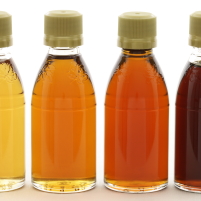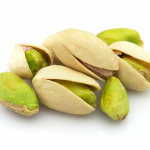The American Indians taught the Colonists how to tap the maple tree for its sap and boil it down to what the Indians called “Sweetwater.” Canada, New York and Vermont are all known for their superior maple products. Maple syrup is graded according to color and flavor. Generally, U.S. grades are: Fancy or Grade AA, a light amber colored syrup with a mild flavor; Grade A is medium amber and mellow flavored; Grade B is dark amber and hearty flavored; and Grade C is very dark with a robust, molasses like flavor. Since the processing of maple syrup is labor-intendisve, pure maple syrup is quite expensive. A less costly product is labeled maple-flavored syrup and is a combination of less expensive syrup, such as corn syrup, and a small amount of pure maple syrup. Pancake syrups are usually nothing more than corn syrup flavored with artificial maple extract. Go for broke and get the good stuff and refrigerate after opening.
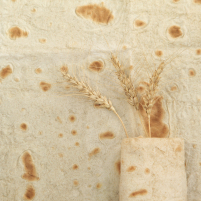
Lavash? Lavosh? Either will do!
This wonderful low-carb bread that’s also known as Armenian cracker bread, is either round or rectangular that’s thin and a little crispy but soft enough to make a great, flavorful wrap sandwich. You’ll find in most Middle Eastern markets and many supermarkets as it is becoming more popular. You’ll even find at Trader Joe’s and it’s even in a wheat version. I use these for delicious turkey or beef wrap sandwiches with a flavorful mayonnaise. You can also cut up the lavosh sandwiches like little sushi rolls and secure with a toothpick and now you have a yummy little appetizer snack for your next celebration or gathering.
Pepperoncini!
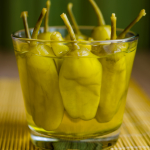 Pepperoncini – pronounced: pep-per-awn-CHEE-nee) Also called Tuscan peppers. These thin skinned bright yellow peppers are very mild and packed with little seeds. They have a slightly sweet and mild flavor and are really not that hot at all. You’ll find them usually pickled on an antipasti platter and are also served as a condiment to some sandwiches such as pastrami’s. Try them finely chopped in your next sour cream based dip.
Pepperoncini – pronounced: pep-per-awn-CHEE-nee) Also called Tuscan peppers. These thin skinned bright yellow peppers are very mild and packed with little seeds. They have a slightly sweet and mild flavor and are really not that hot at all. You’ll find them usually pickled on an antipasti platter and are also served as a condiment to some sandwiches such as pastrami’s. Try them finely chopped in your next sour cream based dip.
FEE-Loh! or Phyllo!
 Literally translated, the Greek word “Phyllo” means “leaf”. In the culinary world it refers to tissue-thin layers of pastry dough used in various Greek and Middle Eastern sweet and savory preparations. It’s best known to be used in the dessert “Baklava” and in “Spanokopita” – the mini spinach appetizers that are folded like a flag. You can find phyllo (or filo) in the frozen section in your grocery store. When frozen it can be stored up to 1 year and in the refrigerator for 1 month. Once opened, use within 2-3 days. Try to protect the delicate sheets of dough by placing a slightly damp paper towel over the unused phyllo as your assembling your dish – it tends to dry out very, very quickly and take it from me… it’s a BEAR (insert word here instead) to have phyllo become brittle when you’re trying to assemble a dish or appetizer (I have flag folded many a spanokopita in my days……)
Literally translated, the Greek word “Phyllo” means “leaf”. In the culinary world it refers to tissue-thin layers of pastry dough used in various Greek and Middle Eastern sweet and savory preparations. It’s best known to be used in the dessert “Baklava” and in “Spanokopita” – the mini spinach appetizers that are folded like a flag. You can find phyllo (or filo) in the frozen section in your grocery store. When frozen it can be stored up to 1 year and in the refrigerator for 1 month. Once opened, use within 2-3 days. Try to protect the delicate sheets of dough by placing a slightly damp paper towel over the unused phyllo as your assembling your dish – it tends to dry out very, very quickly and take it from me… it’s a BEAR (insert word here instead) to have phyllo become brittle when you’re trying to assemble a dish or appetizer (I have flag folded many a spanokopita in my days……)
Lemon Bars!
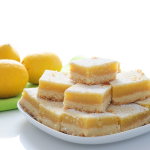 In tribute to a very special someone – today we honor the lemon bar! Well, at least I do by sharing my recipe….
In tribute to a very special someone – today we honor the lemon bar! Well, at least I do by sharing my recipe….
For a half sheet pan (13″x18’x1″), mix together 3/4 cup of sugar, 3 cups of flour and pinch of salt. Cut in 1-1/2 cups of cold butter and mix gently. Pat into the pan to form the crust. Chill for about 10-15 minutes in refrigerator, then bake at 350 for about 20 minutes until just slightly brown. While the crust is cooking, mix together 9 eggs, 4-1/2 cups sugar, 2 cups fresh lemon juice and 1-1/2 cups of flour. Whisk together well. When crust is done, cool about 3-5 minutes then add the lemon-egg mixture then bake for about 35 minutes at 350 degrees. Cool completely, maybe even overnight in refrigerator. Cut into squares and enjoy – “This one’s for you!”
Nutmeg! Use it whole and grate….
This is one of my fav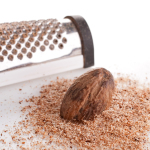 orite spices to use fresh. Supposedly Columbus was actually looking for this spice in the east indies when he sailed from Spain. This seed comes from the nutmeg tree and was extremely popular in the 15th to the 19th century. the hard, egg-shaped nutmeg seed is grayish brown and about 1 inch long. The flavor and aroma are delicately warm, spicy and sweet. It is sold ground and whole but I say purchase it whole and use a grinder as pictured or a micro-plane zester for freshly ground – it makes a big difference. It is excellent when used in baked goods, milk or cream based sauces and custards. It’s also complimentary to many vegetables like spinach, squash and potatoes! Once you use it whole, you’ll never buy the jar of ground nutmeg again.
orite spices to use fresh. Supposedly Columbus was actually looking for this spice in the east indies when he sailed from Spain. This seed comes from the nutmeg tree and was extremely popular in the 15th to the 19th century. the hard, egg-shaped nutmeg seed is grayish brown and about 1 inch long. The flavor and aroma are delicately warm, spicy and sweet. It is sold ground and whole but I say purchase it whole and use a grinder as pictured or a micro-plane zester for freshly ground – it makes a big difference. It is excellent when used in baked goods, milk or cream based sauces and custards. It’s also complimentary to many vegetables like spinach, squash and potatoes! Once you use it whole, you’ll never buy the jar of ground nutmeg again.
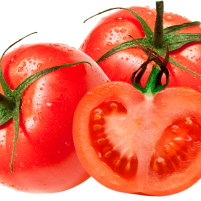
Not an apple at all!
Pomodoro! Literally translating to “golden apple”, pomodoro is Italian for “tomato” the first tomatoes in Italy were actually a yellowish color. Next time you’re at an Italian restaurant and you see “Al Pomodoro” on the menu – no, it’s not that guy you went to high school with – it means that the dish is served with tomato sauce!!!
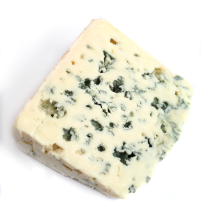
The King of Blue Cheese? Roquefort!
Roquefort is at least one of the oldest and best known in the world. This fabulous blue cheese has been enjoyed since Roman times – even Caesar was a fan! It is made from sheep’s milk that is exposed to a mold known as Penicillium roqueforti and aged for about 3 months or more in the limestone caverns of Mount Comaulou near the village of Roquefort in southwestern France. Roquefort has a creamy-rich texture and pungent, piquant, somewhat salty flavor. It has a creamy white interior with blue veins and an ivory rind. It’s sold in foil wrapped cylinders. This is a great cheese to serve at the end of the meal with a fine port or dessert wine. The MINIMUM fat content for Roquefort is 52%…. explains a lot now…..
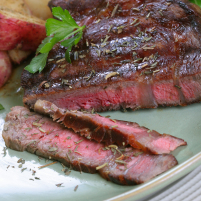
Grillin time! Ribeye!
It’s that time of year to break out the grill and slap a nice rib-eye steak down! This tender, flavorful beef steak is a boneless cut from the rib section – between the short loin and the chuck. If the bones are removed the result is the extremely tender rib-eye steak. If bones left in, then known as a rib-steak. Both should be quickly cooked by grilling, broiling or frying.
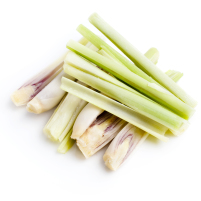
Lemongrass – You can’t smoke it!
So important in Thai and Vietnamese cooking is this herb that has long, thin, gray green leaves and a woody like scallion base. Citral, an essential oil found in lemon peel gives lemon grass its sour lemon flavor and fragrance. Available fresh or dried in Asian markets and some higher end supermarkets. Store fresh lemon grass in refrigerator , tightly wrapped in a plastic bag for up to 2 weeks. Use the white base up to where the leaves begin to branch to flavoring tea, sauces, soups and curry dishes. – Definitely discard before using as you wouldn’t want this woody thistle between your teeth or down your throat!!
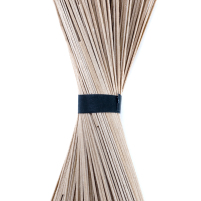
Soba – A new way to get your noodle on!
Soba is the Japanese name for buckwheat. It is synonymous with a type of thin noodle made from buckwheat flour, and in Japan can refer to any thin noodle. The noodle has a dark brownish gray color that comes from the buckwheat. Soba noodles are served either chilled with a dipping sauce, or in hot broth as a noodle soup. It takes three months for buckwheat to be ready for harvest, so it can be harvested four times a year, mainly in spring, summer, and autumn. In Japan, buckwheat is produced mainly in Hokkaido. Soba that is made with newly harvested buckwheat is called “shin-soba”. It is sweeter and more flavorful than regular soba. Udon noodles – the relative to the Soba is similar to spaghetti. It can be round or squared and made from wheat or corn flour.
Some establishments, especially cheaper and more casual ones, may serve both soba and udon as they are often served in a similar manner. Soba is the traditional noodle of choice for the people of Tokyo.
Don’t be scared of the Blood Orange!
 Grown primarily around the Mediterranean and now California (yay!), this sweet-tart orange has a bright red flesh. Most blood oranges are best eaten fresh, but the more acidic varieties like the Maltese work well in cooked sauces like the Hollandaise based Maltaise sauce.
Grown primarily around the Mediterranean and now California (yay!), this sweet-tart orange has a bright red flesh. Most blood oranges are best eaten fresh, but the more acidic varieties like the Maltese work well in cooked sauces like the Hollandaise based Maltaise sauce.
The flesh develops its characteristic maroon color when the fruit develops with low temperatures during the night. Sometimes there is dark coloring on the exterior of the rind as well, depending on the variety of blood orange. The skin can be tougher and harder to peel than that of other oranges. The blood orange is a natural mutation of the orange.
Blood oranges may have originated in either China or the Southern Mediterranean, where they have been grown since the 18th century. They are now the primary orange grown in Italy. Italy. The anthocyanins which give the orange its distinct maroon color will only develop when temperatures are low at night, as during the Mediterranean fall and winter. Blood oranges cultivated in the United States are in season from December to March (Texas), and from November to May (California). Since they are only around in the spring season and make such a lovely addition to your mimosa instead of regular orange juice – a bright vibrant color. If you can, juice these oranges and freeze the juice for use all year round.
Blood oranges have a unique flavor profile compared to other oranges, being distinctly raspberry-like in addition to the usual citrus notes.
Some blood orange juice may be somewhat tart, while other kinds are sweet while retaining the characteristic blood orange taste. The oranges can also be used to create marmalade, and the zest can be used for baking. A popular Sicilian winter salad is made with sliced blood oranges, sliced bulb fennel, and olive oil. The oranges have also been used to create gelato, sorbet and Italian Soda. Blood oranges are also popular in vinaigrette-style dressings, and are sometimes used to flavor niche-market beer.
Blood oranges are a source of vitamin C like all citrus fruits. A medium-sized orange also provides 28% of the recommended daily intake of dietary fiber.
Vinegar – the Basis of a Good Dressing or Sauce….
Vineg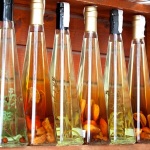 ar is derived from the French vin aigre, “sour wine” – vinegar is made by bacterial activity that converts fermented liquids such as wine, beer or cider into a weak solution of acetic acide, which makes it sour. There are a myriad of vinegars on the market days. You have the fruity apple cider vinegar, made from fermented apple cider; the harsh-tasting distilled white vinegar and the please pungent vinegars made from either red or white wine. Then there’s malt vinegar, obtained from malted barley, the mild slightly sweet rice vinegar, made from fermented rice; and a dazzling array of fruit and herb flavored vinegars that you can find at more upscale markets or gourmet stores. Keep your vinegars in a cool dry place, avoiding keeping them around your hot stove/oven as that will diminish their flavor – they’ll look good but really not assist you in your cooking. Unopened vinegar will keep indefinitely while open vinegar will keep up to 6 months. Experiment when you can with vinegar for dressings and sauces, tasting while you go – remember ¼ vinegar to ¾ oil when you’re making a salad dressing.
ar is derived from the French vin aigre, “sour wine” – vinegar is made by bacterial activity that converts fermented liquids such as wine, beer or cider into a weak solution of acetic acide, which makes it sour. There are a myriad of vinegars on the market days. You have the fruity apple cider vinegar, made from fermented apple cider; the harsh-tasting distilled white vinegar and the please pungent vinegars made from either red or white wine. Then there’s malt vinegar, obtained from malted barley, the mild slightly sweet rice vinegar, made from fermented rice; and a dazzling array of fruit and herb flavored vinegars that you can find at more upscale markets or gourmet stores. Keep your vinegars in a cool dry place, avoiding keeping them around your hot stove/oven as that will diminish their flavor – they’ll look good but really not assist you in your cooking. Unopened vinegar will keep indefinitely while open vinegar will keep up to 6 months. Experiment when you can with vinegar for dressings and sauces, tasting while you go – remember ¼ vinegar to ¾ oil when you’re making a salad dressing.
Endive… Escarole! Ole!
There are di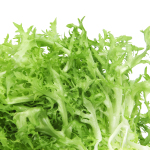 fferent varieties of Endive – this one is the Escarole which is a member of the chicory family. It has a broad, slightly curved, pale green leaves with a milder flavor than either Belgian or curly endive. Both curly endive and escarole are available year-round, with the peak season from June through October. They should be selected for their fresh, crisp texture, avoid heads with discoloration or insect damage. Store the escarole, tightly wrapped in the refrigerator for up to 3 days. It can be used in salad but can salads, but briefly cooked and eaten as a vegetable or in soups.
fferent varieties of Endive – this one is the Escarole which is a member of the chicory family. It has a broad, slightly curved, pale green leaves with a milder flavor than either Belgian or curly endive. Both curly endive and escarole are available year-round, with the peak season from June through October. They should be selected for their fresh, crisp texture, avoid heads with discoloration or insect damage. Store the escarole, tightly wrapped in the refrigerator for up to 3 days. It can be used in salad but can salads, but briefly cooked and eaten as a vegetable or in soups.
Exotic Rice that’s most fabulous
Black  rice (also known as purple rice) is an heirloom variety of glutinous rice cultivated in Asia. It is typically sold as an unmilled rice, meaning the fiber-rich black husks of the rice are not removed. The unusual color makes it very popular for desserts, and the high nutritional value is an added benefit. This rice is often served with fresh fruit such as mangoes and lychees, especially when drizzled with a fruit or rice syrup.Soaking and cooking reveals the true color of this rice, which is actually a rich purple to burgundy, though the grains do appear to be black when they are uncooked. The natural color of the rice will dye foods added to it, such as coconut milk. It can also be eaten with entree courses, although this is less common. This grain is often used to make Chinese desserts, though it is also popular in many other Asian nations, all of which have their own special names for the product. It is also claimed to be good for the kidney, stomach and liver.
rice (also known as purple rice) is an heirloom variety of glutinous rice cultivated in Asia. It is typically sold as an unmilled rice, meaning the fiber-rich black husks of the rice are not removed. The unusual color makes it very popular for desserts, and the high nutritional value is an added benefit. This rice is often served with fresh fruit such as mangoes and lychees, especially when drizzled with a fruit or rice syrup.Soaking and cooking reveals the true color of this rice, which is actually a rich purple to burgundy, though the grains do appear to be black when they are uncooked. The natural color of the rice will dye foods added to it, such as coconut milk. It can also be eaten with entree courses, although this is less common. This grain is often used to make Chinese desserts, though it is also popular in many other Asian nations, all of which have their own special names for the product. It is also claimed to be good for the kidney, stomach and liver.
It also has a very rich, slightly sweet, strongly nutty flavor. The rice is naturally high in iron, which causes the dense purple color, and it is also high in fiber, since the bran is left on the rice. It is also rich in a variety of other valuable vitamins and minerals. You can find the black rice at Trader Joe’s and other variety of grocery stores. It’s very simple to cook and will add a nice variety to your dishes.
Cashew! Bless you!
This kid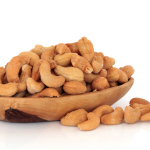 ney shaped nut grows out from the bottom of the cashew apple. Cashew nuts have a sweet, buttery flavor and contain about 48 percent fat. Because of their high fat content, they should be stored, tightly wrapped, in the freezer to keep from going rancid. If you roast them, their nutty flavor will increase.
ney shaped nut grows out from the bottom of the cashew apple. Cashew nuts have a sweet, buttery flavor and contain about 48 percent fat. Because of their high fat content, they should be stored, tightly wrapped, in the freezer to keep from going rancid. If you roast them, their nutty flavor will increase.
The cashew nut is served as a snack or used in recipes, like other nuts, although it is actually a seed, even though we will call it a nut. The cashew apple is a fruit, whose pulp can be processed into a sweet, astringent fruit drink or distilled into liqueur.
Did you know the shell of the cashew nut is toxic, which is why the nut is never sold in the shell to consumers?
Cashew nuts are commonly used in Indian cuisine, whole for garnishing sweets or curries, or ground into a paste that forms a base of sauces for curries or some sweets. It is also used in powdered form in the preparation of several Indian sweets and desserts. In Goan cuisine, both roasted and raw kernels are used whole for making curries and sweets.
Tomorrow – Cinco De! Be Healthy
This 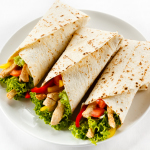 Mexican-style “Sandwich” consists of a folding corn or flour tortilla filled with various ingredients such as beef, pork, chicken, chorizo sausage, seafood, tomatoes, lettuce, cheese, etc. Here’s a version of a healthy taco filled with vegetables and chicken. Tacos can be had as an entrée or snack. They can be fried for a hard shelled taco, but you’ll be getting all the calories. Soft shell may be the way to go, try with a wheat tortilla for an even healthier snack or dinner. Great side dish for that margarita or cerveza for Cince De Mayo manana!
Mexican-style “Sandwich” consists of a folding corn or flour tortilla filled with various ingredients such as beef, pork, chicken, chorizo sausage, seafood, tomatoes, lettuce, cheese, etc. Here’s a version of a healthy taco filled with vegetables and chicken. Tacos can be had as an entrée or snack. They can be fried for a hard shelled taco, but you’ll be getting all the calories. Soft shell may be the way to go, try with a wheat tortilla for an even healthier snack or dinner. Great side dish for that margarita or cerveza for Cince De Mayo manana!
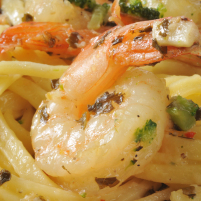
National Shrimp Scampi Day!!
In the USA, “scampi” is often the menu name for shrimp in Italian-American cuisine (the actual word for “shrimp” in Italian is gambero or gamberetto, plural gamberi or gamberetti. The term “scampi”, by itself, is also the name of a dish of shrimp served in garlic butter and dry white wine, served either with bread, or over pasta or rice, although sometimes just the shrimp alone. Most variants of the “shrimp scampi” come on pasta. The word “scampi” is often construed as that style of preparation rather than an ingredient, with that preparation being called “shrimp scampi”, and with variants such as “chicken scampi”.
Scampi is the Italian plural of scampo, meaning prawn, but it can be used as singular, plural, or uncountable in English. The Italian word may be derived from the Greek kampē (“bending” or “winding”).
It’s a delicious easy to make dish you really ought to try – don’t overcook the shrimp as they can become rubbery with overcooking. Use fresh garlic, not that jar stuff with chemicals.
Source: Wikipedia & Commentary
“Little Oranges”? Read on!
Aran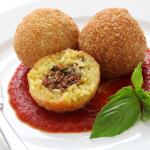 cine (Air-Ran-CHEE-Knee) A Sicilian specialty of saffron flavored rice balls stuffed with varying ingredients that can include meat, meat sauce, vegetables and/or cheese. The rice balls are coated with breadcrumbs and usually fried, though they can also be baked. The word arancine means “little oranges” and refers to both the shape of the fruit and the orange color from the saffron. Arancine are a popular street food and often used as appetizers. If you see this on your favorite Italian restaurant menu, try it!
cine (Air-Ran-CHEE-Knee) A Sicilian specialty of saffron flavored rice balls stuffed with varying ingredients that can include meat, meat sauce, vegetables and/or cheese. The rice balls are coated with breadcrumbs and usually fried, though they can also be baked. The word arancine means “little oranges” and refers to both the shape of the fruit and the orange color from the saffron. Arancine are a popular street food and often used as appetizers. If you see this on your favorite Italian restaurant menu, try it!
Cardamom – Good Spice!
A member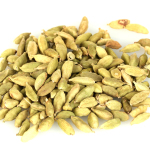 of the ginger family, this aromatic spice is native to India and grows in many other tropical areas including Asia, South America and the Pacific Islands. Cardamom seeds are encapsulated in small pods about the size of a cranberry. Each pod containers 17 to 20 tiny seeds. Cardamom has a pungent aroma and a warm, spicy-sweet flavor. You can purchase cardamom by either pod (pictured) or ground, the latter more convenience is not as full flavored because cardamom seeds begin to lose their essential oils as soon as they are ground. You can attempt to ground yourself using a mortar and pestle or spice grinder. If using this method in a soup or stew, the shell will disintegrate in the broth while the dish cooks. If using in a baked good, purchase the already ground cardamom. Be frugal when using cardamom – a little goes a long way.
of the ginger family, this aromatic spice is native to India and grows in many other tropical areas including Asia, South America and the Pacific Islands. Cardamom seeds are encapsulated in small pods about the size of a cranberry. Each pod containers 17 to 20 tiny seeds. Cardamom has a pungent aroma and a warm, spicy-sweet flavor. You can purchase cardamom by either pod (pictured) or ground, the latter more convenience is not as full flavored because cardamom seeds begin to lose their essential oils as soon as they are ground. You can attempt to ground yourself using a mortar and pestle or spice grinder. If using this method in a soup or stew, the shell will disintegrate in the broth while the dish cooks. If using in a baked good, purchase the already ground cardamom. Be frugal when using cardamom – a little goes a long way.
Dolmas – savory treat!
Dolma is singul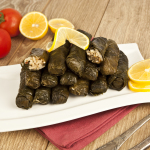 ar, dolmades plural. From the Arabic word for “something stuffed,” referring to grape leaves, vegetables or fruits stuffed with a savory, well-seasoned filling. Among the most popular dolmades are grape leaved stuffed with a filling of ground lamb, rice, onion, currants, pinenuts and various seasonings. Other foods used as casings include squash, eggplant, sweet peppers, cabbage leaves, quinces and apples. Dolmades are usually braised or baked in liquid and/or olive oil and topped with a bit of lemon juice right before serving. The dolmades containing meat are usually served warm while the ones with rice and vegetables are good cold or room temperature. They are very time consuming to make but well worth it. You can find the grape leaves as international markets in the Middle Eastern section.
ar, dolmades plural. From the Arabic word for “something stuffed,” referring to grape leaves, vegetables or fruits stuffed with a savory, well-seasoned filling. Among the most popular dolmades are grape leaved stuffed with a filling of ground lamb, rice, onion, currants, pinenuts and various seasonings. Other foods used as casings include squash, eggplant, sweet peppers, cabbage leaves, quinces and apples. Dolmades are usually braised or baked in liquid and/or olive oil and topped with a bit of lemon juice right before serving. The dolmades containing meat are usually served warm while the ones with rice and vegetables are good cold or room temperature. They are very time consuming to make but well worth it. You can find the grape leaves as international markets in the Middle Eastern section.
Kiwi – AKA Chinese Gooseberry
Native to China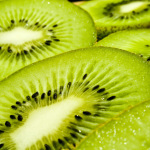 , this odd-looking kiwi received its moniker from New Zealand’s national (and flightless) bird of the same name. It looks like a large brown fuzzy egg. The covering actually hides a beautiful, brilliant green flesh, spattered with tiny edible black seeds. Kiwi flavor is elusive – some say the flavor of pineapple, others say strawberry but all agree that it has a sweet tart flavor unlike any other fruit. The kiwi is cultivated in both New Zealand and California. This fruit is available pretty much all year-round. Ripe kiwis will give slightly to gentle pressure and can be stored in the refrigerator up to 3 weeks. Two kiwis contain more potassium than a banana, as much fiber as a grapefruit and twice as much vitamin C as an orange. You can ripen them faster by placing the kiwi in a brown bag with an apple or banana. Seal and let stand at room temperature overnight. The ethylene gas emitted by the apple or banana help other fruit ripen more quickly … .but that’s another tip for another time.
, this odd-looking kiwi received its moniker from New Zealand’s national (and flightless) bird of the same name. It looks like a large brown fuzzy egg. The covering actually hides a beautiful, brilliant green flesh, spattered with tiny edible black seeds. Kiwi flavor is elusive – some say the flavor of pineapple, others say strawberry but all agree that it has a sweet tart flavor unlike any other fruit. The kiwi is cultivated in both New Zealand and California. This fruit is available pretty much all year-round. Ripe kiwis will give slightly to gentle pressure and can be stored in the refrigerator up to 3 weeks. Two kiwis contain more potassium than a banana, as much fiber as a grapefruit and twice as much vitamin C as an orange. You can ripen them faster by placing the kiwi in a brown bag with an apple or banana. Seal and let stand at room temperature overnight. The ethylene gas emitted by the apple or banana help other fruit ripen more quickly … .but that’s another tip for another time.
Italian Dessert to make you swoon!
This beautiful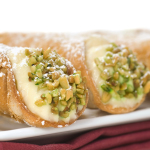 Italian dessert consisting of tubular or horn-shaped pastry shells that have been deep fried, then filled with a sweetened filling of whipped ricotta cheese and sometimes whipped crème or mascarpone cheese which may have been flavored with vanilla or orange flower water and maybe a hint of cinnamon. Chopped pistachios, semi-sweet chocolate pieces and candied citrus peel or cherries are still oven included, dotting the open ends of the pastries. I can still taste the one I had in Taormina, Italy back in summer of 2000 – it was magical!!!
Italian dessert consisting of tubular or horn-shaped pastry shells that have been deep fried, then filled with a sweetened filling of whipped ricotta cheese and sometimes whipped crème or mascarpone cheese which may have been flavored with vanilla or orange flower water and maybe a hint of cinnamon. Chopped pistachios, semi-sweet chocolate pieces and candied citrus peel or cherries are still oven included, dotting the open ends of the pastries. I can still taste the one I had in Taormina, Italy back in summer of 2000 – it was magical!!!
Panzanella Salad!
This bright gorg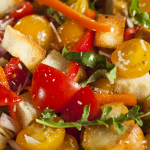 eous dish is an Italian bread salad made with onions, tomatoes, basil, olive oil, vinegar and seasoning and chunks of bread. Some versions may include cucumbers, anchovies and /or peppers. Try it with toasted bread chunks with a little garlic or by sautéing bread chunks in a little olive oil to add that crunch to the salad. The 16th Century artist and poet Bronzino sings the praises of onions with oil and vinegar served with toast then sings the praises of a salad with onions and cucumbers. This is often interpreted as the description of panzanella. Pan meaning bread in many languages. Great way to use up those leftover tomatoes and baguette of bread. A glass of red wine and dinner is complete!
eous dish is an Italian bread salad made with onions, tomatoes, basil, olive oil, vinegar and seasoning and chunks of bread. Some versions may include cucumbers, anchovies and /or peppers. Try it with toasted bread chunks with a little garlic or by sautéing bread chunks in a little olive oil to add that crunch to the salad. The 16th Century artist and poet Bronzino sings the praises of onions with oil and vinegar served with toast then sings the praises of a salad with onions and cucumbers. This is often interpreted as the description of panzanella. Pan meaning bread in many languages. Great way to use up those leftover tomatoes and baguette of bread. A glass of red wine and dinner is complete!
Hoisin Sauce. You’ve seen it… what is it?
Also called 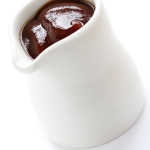 Peking sauce, this thick, reddish brown sauce is sweet and spicy, and widely used in Chinese cooking. It’s a mixture of soybeans, garlic, chili and various spices. Hoisin is mainly used as a table condiment and as a flavoring agent for many meat, poultry and shellfish dishes. It can be found in the Asian section of your supermarket and in many larger grocery stores. Once opened, canned hoisin should be transferred to a non-metal container, tightly sealed and refrigerated. Bottled hoisin can be refrigerated as is. Both will keep indefinitely when stored in this manner. Add a little hoisin to some sesame oil, soy sauce and you’ll have a lovely dipping sauce for dumplings and eggrolls. Add hoisin sauce to BBQ sauce and give your next rack of ribs an Asian inspiration!
Peking sauce, this thick, reddish brown sauce is sweet and spicy, and widely used in Chinese cooking. It’s a mixture of soybeans, garlic, chili and various spices. Hoisin is mainly used as a table condiment and as a flavoring agent for many meat, poultry and shellfish dishes. It can be found in the Asian section of your supermarket and in many larger grocery stores. Once opened, canned hoisin should be transferred to a non-metal container, tightly sealed and refrigerated. Bottled hoisin can be refrigerated as is. Both will keep indefinitely when stored in this manner. Add a little hoisin to some sesame oil, soy sauce and you’ll have a lovely dipping sauce for dumplings and eggrolls. Add hoisin sauce to BBQ sauce and give your next rack of ribs an Asian inspiration!
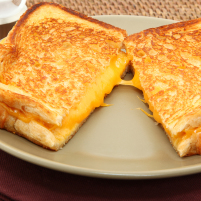
National Grilled Cheese Day! YAY!!
Cooked bread and cheese is an ancient food, according to food historians, popular across the world in many cultures; evidence indicates that in the U.S., the modern version of the grilled cheese sandwich originated in the 1920s when inexpensive sliced bread and American cheese became easily available. The so-called cheese dream became popular in the United States of America during the Great Depression.
It was originally made as an open sandwich, but the top slice of bread became common by the 1960s.U.S. government cookbooks describe Navy cooks broiling “American cheese filling sandwiches” during World War II. Many versions of the grilled cheese sandwich can now be found on restaurant menus across the United States and internationally.
A grilled cheese sandwich is assembled and then heated until the bread crisps and the cheese melts, sometimes combined with an additional ingredient such as bacon, tomatoes or onions. Several different methods of heating the sandwich are used, depending on the region and personal preference. Common methods include being cooked on a griddle, grilled, fried in a pan or made in a panini grill or sandwich toaster (this method is more common in the United Kingdom where the sandwiches are normally called “toasted sandwiches” or “toasties” and in Australia where they are called “jaffles”). A clothes iron has also been utilized to make a grilled cheese in a pinch, as in a hotel room where there are no other cooking appliances.
When making grilled cheese on an open griddle or pan, one side is cooked first, then the sandwich is flipped and cooked on the other side. The sandwich is finished when both sides are toasted and the cheese has melted. Butter, oil, or mayonnaise may first be spread on either the bread or the cooking surface in the case of butter and oil. An alternative technique is to toast or grill each half of the sandwich separately, then combine them. Another method sometimes referred as an “inside out” grilled cheese has an extra layer of cheese put on the outside of each side and cooked, causing the cheese to caramelize into a crispy outer layer.
When using butter best results are achieved at a medium heat. This prevents the milk solids in butter from burning and allows sufficient time for heat to thoroughly penetrate the sandwich and melt the cheese without burning the bread. A crispy golden-brown crust with a melted cheese center is a commonly preferred level of preparedness. Cooking times can vary depending on pan dimensions, ability to control the intensity of the heat source, bread type, cheese variety and overall thickness of pre-cooked sandwich.
Source: Wikipedia
Burrata! A New Take on Mozzarella
This lovely che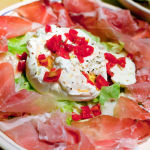 ese is an Italian creation made by the pasta filata process, whereby the fresh curd is dipped into hot whey, then stretched and kneaded to the desired pliability. To create Burrata, the cheesemaker uses the stretched curd to form a bag about 1/3” thick, which is filled with bits of unspun mozzarella and cream. The top is twisted closed and the pouch is dipped in brine. The cream thickens inside the bag, which produces a soft, rich center with a fresh milk quality that oozes out when the cheese is cut. This fresh cheese can be found in specialty cheese shops, Trader Joes, and gourmet type grocery stores. It must be refrigerated immediately and consumed within a few days. Most come from Italy though it is now produced in the United States, more locally there is a cheesemaker in El Monte that specializes in making Burrata. If you ever see this on the menu – take a chance and order it, you won’t be sorry!
ese is an Italian creation made by the pasta filata process, whereby the fresh curd is dipped into hot whey, then stretched and kneaded to the desired pliability. To create Burrata, the cheesemaker uses the stretched curd to form a bag about 1/3” thick, which is filled with bits of unspun mozzarella and cream. The top is twisted closed and the pouch is dipped in brine. The cream thickens inside the bag, which produces a soft, rich center with a fresh milk quality that oozes out when the cheese is cut. This fresh cheese can be found in specialty cheese shops, Trader Joes, and gourmet type grocery stores. It must be refrigerated immediately and consumed within a few days. Most come from Italy though it is now produced in the United States, more locally there is a cheesemaker in El Monte that specializes in making Burrata. If you ever see this on the menu – take a chance and order it, you won’t be sorry!
A New Cheese to try…..
Cotija is a Hispa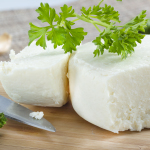 nic-style cheese named after the town of Cotija de la Paz in the Mexican state of Michoacán. This hard, crumbly Mexican cheese is made mainly from cow’s milk
nic-style cheese named after the town of Cotija de la Paz in the Mexican state of Michoacán. This hard, crumbly Mexican cheese is made mainly from cow’s milk
When the cheese is made, it is white, fresh and salty thus bearing immense resemblance to feta cheese. However, with aging it becomes hard and crumbly like Parmigiano-Reggiano. Its similarity with Parmesan has earned it the nickname “Parmesan of Mexico”. The aged version of Cotija is referred to as “anejo”. You may also see it labeled as Queso Anejo
Traditionally, Cotija cheese was made with raw milk aged for three to twelve months. But the commercial productions add an enzyme to speed up the ripening process. This need for acceleration gives the commercial produce a slight change in flavor compared to the artisanal variety.
Since, Cotija cheese is very salty, strongly flavored, firm and does not actually melt, it is used for grating on salads, soups, casseroles, tacos, tostadas and chili. In Mexico, it is also widely used to enhance the flavor of many savory dishes by mixing directly into the casserole or recipe. In the U.S. it is increasingly popular on pasta. It is typically shredded onto cooked foods, also in salads and with fruit.
Parchment: A Kitchen Friend
This has b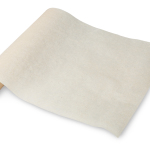 ecome a “best friend” to any chef/home cook – it’s been a staple in the Chefelle kitchen for years. Makes clean up a breeze on baking sheets. It’s popularity has made it more accessible in your favorite grocery stores.
ecome a “best friend” to any chef/home cook – it’s been a staple in the Chefelle kitchen for years. Makes clean up a breeze on baking sheets. It’s popularity has made it more accessible in your favorite grocery stores.
Parchment paper and bakery release paper are cellulose-based papers that are used in baking as a disposable non-stick surface. Both are also called bakery paper or baking paper. It should not be confused with either writing parchment nor waxed paper, also known as wax paper or rarely as butter paper.
A common use is to eliminate the need to grease sheet pans and the like, allowing very rapid turn-around of batches of baked goods. Parchment paper is also used to cook en papillote, a technique where food is steamed or cooked within closed pouches made from parchment paper.
Bakery paper can be used in most applications that call for wax paper as a non-stick surface. The reverse is not true, as using wax paper will cause smoke in the oven and affect taste.
Source: Wikipedia & commentary
Almonds – not just in candy bars anymore….
The almon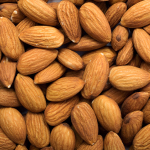 d is really not a nut at all but the kernel of the almond tree fruit which are grown extensively in California, the Mediterranean, Australia and South America. There are 2 main types of almonds, sweet and bitter. The flavor of sweet almonds is delicate and slightly sweet and are readily available in markets and are the variety used in recipes. They carry a healthy dose of oleic acid, an antioxidant. In a nutshell, almonds are a nutritional powerhouse packed with calcium, fiber, folic acid, magnesium, potassium, riboflavin and vitamin E. For the sweet almonds, toasting them before using in recipes intensifies their flavor and adds crunch. The sale of bitter almonds is illegal in the United states due to the toxicity that is destroyed wtihin the nuts are heated. When they are processed they are used to flavor extracts and liqueurs.
d is really not a nut at all but the kernel of the almond tree fruit which are grown extensively in California, the Mediterranean, Australia and South America. There are 2 main types of almonds, sweet and bitter. The flavor of sweet almonds is delicate and slightly sweet and are readily available in markets and are the variety used in recipes. They carry a healthy dose of oleic acid, an antioxidant. In a nutshell, almonds are a nutritional powerhouse packed with calcium, fiber, folic acid, magnesium, potassium, riboflavin and vitamin E. For the sweet almonds, toasting them before using in recipes intensifies their flavor and adds crunch. The sale of bitter almonds is illegal in the United states due to the toxicity that is destroyed wtihin the nuts are heated. When they are processed they are used to flavor extracts and liqueurs.
Passover the Horseradish, please?
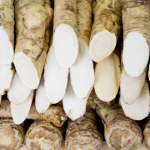 This ancient herb is featured as one of the five bitter herbs of the Jewish Passover festival which starts today. It is a native of Eastern Europe but now grows on other part of Europe as well as the United States. Though it has spiky green leaves that can be used in salads, horseradish is grown mainly for its large, white, pungently spicy roots. It’s roots belong to the mustard family. It has virtually no aroma until you scratch its skin; then, it will emit a sharp, penetrating aroma, similar to mustard oil, causing the eyes to water. It’s a main staple in the Japanese wasabi. Choose roots that are firm with no sign of blemishes or withering. It should be refrigerated, wrapped in a plastic bag and peeled before using. It is most often grated and used in sauces or as a condiment with fish or meat. Add it to sour cream and/or yogurt and you have the creamed horseradish sauce that is a compliment to prime rib.
This ancient herb is featured as one of the five bitter herbs of the Jewish Passover festival which starts today. It is a native of Eastern Europe but now grows on other part of Europe as well as the United States. Though it has spiky green leaves that can be used in salads, horseradish is grown mainly for its large, white, pungently spicy roots. It’s roots belong to the mustard family. It has virtually no aroma until you scratch its skin; then, it will emit a sharp, penetrating aroma, similar to mustard oil, causing the eyes to water. It’s a main staple in the Japanese wasabi. Choose roots that are firm with no sign of blemishes or withering. It should be refrigerated, wrapped in a plastic bag and peeled before using. It is most often grated and used in sauces or as a condiment with fish or meat. Add it to sour cream and/or yogurt and you have the creamed horseradish sauce that is a compliment to prime rib.
A Different Kind of Fool
This old fashi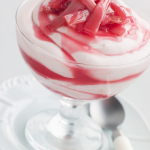 oned dessert form the motherland of England is made of cooked pureed fruit that is strained, chilled and folded into whipped cream. The fruit mixture may or may not be sweetened. I guess depending on the fruit you use. It is traditional made from gooseberries but any fruit may be substituted. It may assist other fruits that are not popular due to their sour or acidic taste like the rhubarb fruit as pictured. The exact reason why the word “fool” is used is known but heck, makes a perfect posting for April Fool’s day!
oned dessert form the motherland of England is made of cooked pureed fruit that is strained, chilled and folded into whipped cream. The fruit mixture may or may not be sweetened. I guess depending on the fruit you use. It is traditional made from gooseberries but any fruit may be substituted. It may assist other fruits that are not popular due to their sour or acidic taste like the rhubarb fruit as pictured. The exact reason why the word “fool” is used is known but heck, makes a perfect posting for April Fool’s day!
Chi-Chi-Chi Chia!
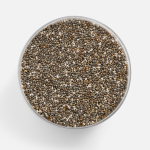 Like flax seeds, chia seed is a rich source of omega-3 fatty acids as well as the omega-6 fatty acid LA, protein and fiber. It also contains several essential nutrients, including calcium, phosphorus, copper, niacin and zine. Because of this, chia seeds, are fast becoming a favorite health food. It’s a member of the mint family and was a significant component of the Aztec and Mayan diets. The seed has a nutlike flavor and is often used simply sprinkled over cereal, yogurt or salads or eaten by itself as a snack. It can also be ground and mixed with flour and used in baked goods. What was once popular in Mexica and Central America is the chia fresca, made by mixing a couple of teaspoon of chia seeds for 8 to 10 ounces of water or fruit juice. Chia seed is naturally gel-like so the mixture will become thickened after a bit of time in your glass. Chia seed, unlike flax seed, does not have a high fat content and can be stored for longer periods without going rancid. Due to the popularity of this seed, you can now find in mostly all the grocery stores and definitely in health food stores like Trader Joes.
Like flax seeds, chia seed is a rich source of omega-3 fatty acids as well as the omega-6 fatty acid LA, protein and fiber. It also contains several essential nutrients, including calcium, phosphorus, copper, niacin and zine. Because of this, chia seeds, are fast becoming a favorite health food. It’s a member of the mint family and was a significant component of the Aztec and Mayan diets. The seed has a nutlike flavor and is often used simply sprinkled over cereal, yogurt or salads or eaten by itself as a snack. It can also be ground and mixed with flour and used in baked goods. What was once popular in Mexica and Central America is the chia fresca, made by mixing a couple of teaspoon of chia seeds for 8 to 10 ounces of water or fruit juice. Chia seed is naturally gel-like so the mixture will become thickened after a bit of time in your glass. Chia seed, unlike flax seed, does not have a high fat content and can be stored for longer periods without going rancid. Due to the popularity of this seed, you can now find in mostly all the grocery stores and definitely in health food stores like Trader Joes.
Oyster Sauce!
You’ll find t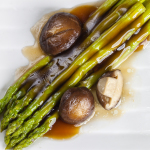 his wonderful condiment in the Asian Section of your grocery store. It’s a dark brown sauce consisting of oysters, brine and soy sauce cooked until thick and concentrated. It is used in many Asian dishes especially stir fry dishes and is also used as a table condiment for many that enjoy this sauce. Oyster sauce gives a richness to dishes without overpowering their original flavor. Try it on your vegetables, especially mushrooms and asparagus as pictured. You can also use it as a dipping sauce if you add a little of hoisin sauce to it for your potstickers or eggrolls.
his wonderful condiment in the Asian Section of your grocery store. It’s a dark brown sauce consisting of oysters, brine and soy sauce cooked until thick and concentrated. It is used in many Asian dishes especially stir fry dishes and is also used as a table condiment for many that enjoy this sauce. Oyster sauce gives a richness to dishes without overpowering their original flavor. Try it on your vegetables, especially mushrooms and asparagus as pictured. You can also use it as a dipping sauce if you add a little of hoisin sauce to it for your potstickers or eggrolls.
Slick News on this oil!
Whe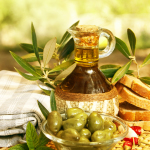 n you press tree-ripened olives they extract a flavorful, monounsaturated oil that is prized throughout the world for both cooking, especially in the Mediterranean countries, and for salads. Today you can find a wide selection of the domestic oil, most comes from the California region but so many are available from the countries of France, Greece, Italy and Spain. And each have their own unique flavor, color and fragrance of olives that dramatically depend on their growing regions and the crops condition. The most common, the Extra Virgin Olive oil is the cold pressed result of the first pressing of the olives and is only 1 percent acid. It’s considered the finest and fruitiest of the olive oils and therefore the most expensive. Try them out with your salads and for cooking – especially when you’re making a Spanish meal, use the Spanish olive oil, Italian? Italian Olive Oil. Heck, host an olive oil tasting next time with a little pieces of French bread and use white little bowls for the different oils and you can see, smell and taste the difference between the olive oils varying from country and their pressings.
n you press tree-ripened olives they extract a flavorful, monounsaturated oil that is prized throughout the world for both cooking, especially in the Mediterranean countries, and for salads. Today you can find a wide selection of the domestic oil, most comes from the California region but so many are available from the countries of France, Greece, Italy and Spain. And each have their own unique flavor, color and fragrance of olives that dramatically depend on their growing regions and the crops condition. The most common, the Extra Virgin Olive oil is the cold pressed result of the first pressing of the olives and is only 1 percent acid. It’s considered the finest and fruitiest of the olive oils and therefore the most expensive. Try them out with your salads and for cooking – especially when you’re making a Spanish meal, use the Spanish olive oil, Italian? Italian Olive Oil. Heck, host an olive oil tasting next time with a little pieces of French bread and use white little bowls for the different oils and you can see, smell and taste the difference between the olive oils varying from country and their pressings.
For the Love of Beef!
Corned be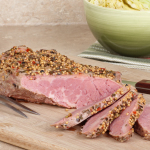 ef is a salt-cured beef product. The term comes from the treatment of the meat with large grained rock salt, also called “corns” of salt. It features as an ingredient in many cuisines, including British, Irish-American, Jewish, Caribbean, Philippine cuisine and Chamorro cuisine (Mariana Islands such as Saipan and Guam)
ef is a salt-cured beef product. The term comes from the treatment of the meat with large grained rock salt, also called “corns” of salt. It features as an ingredient in many cuisines, including British, Irish-American, Jewish, Caribbean, Philippine cuisine and Chamorro cuisine (Mariana Islands such as Saipan and Guam)
It was popular during both World Wars, when fresh meat was rationed. Corned beef remains popular in the United Kingdom and countries with British culinary traditions and is commonly used in sandwiches, corned beefhash or eaten with chips and pickles. It also remains especially popular in Canada in a variety of dishes, perhaps most prominently Montreal smoked meat.
Although the exact beginnings of corned beef are unknown, it most likely came about when people began preserving meat through salt-curing. Evidence of its legacy is apparent in numerous cultures, including Ancient Europe and the Middle East. The word corn derives from Old English, and is used to describe any small hard particles or grains. In the case of “corned beef”, the word may refer to the coarse granular salts used to cure the beef. The word corned may also refer to the corns of potassium nitrate, also known as saltpetre (and one of the main ingredients in gunpowder), which were formerly used to preserve the meat.
In North America corned beef dishes are associated with traditional Irish cuisine. However there is considerable debate about the association of corned beef with Ireland. Mark Kurlansky, in his book Salt, states that the Irish produced a salted beef around the Middle Ages that was the “forerunner of what today is known as Irish corned beef” and in the 17th century the English named the Irish salted beef “corned beef”. Some say it was not until the wave of 18th century Irish immigration to the United States that much of the ethnic Irish first began to consume corned beef dishes as seen today. The popularity of corned beef compared to bacon among the immigrant Irish may have been due to corned beef being considered a luxury product in their native land, while it was cheaply and readily available in America.
In Ireland today, the serving of corned beef is geared toward tourist consumption and most Irish in Ireland do not identify the ingredient as native cuisine.
The Jewish population produced similar koshered cured beef product made from the brisket which the Irish immigrants purchased as corned beef from Jewish butchers. This may have been facilitated by the close cultural interactions and collaboration of these two diverse cultures in the USA’s main 19th and 20th century immigrant port of entry, New York City.
Source: Wikipedia
This is the Chefelle Method of making a tender Corned Beef: Buy either the Flat Cut (minimal fat) or the Point (tip) Cut which has more flavor.
Place your corned beef in a pot, add the seasoning packet if provided and add water, submerging the brisket about halfway through. Bring to a boil and continue boiling for about 3-4 hours, adding water as needed. You can choose to place a lid on the pot or not, but just make sure that water doesn’t evaporate too much. The trick is that this is such a tough piece of meat that this high rolling boil for 3-4 hours finally releases the elasticity of the meat and then it’s as soft and tender as can be. Add the quartered cabbage the last 15 minutes of cooking. And remember to sliced your corned beef AGAINST the grain
It’s all Betta with Feta
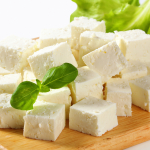 This is a fantastic cheese and one of my personal faves….
This is a fantastic cheese and one of my personal faves….
It’s one of the world’s oldest cheeses and has been made in Greece and other Balkan countries for centuries. Today is made around the world by numerous producers in the countries of Denmark, France, Germany and of course, here in the United States. To truly be called Feta – it must be produced by traditional methods designated in Greece and made from sheep’s milk although 30% of goat’s milk may be added. Large commercial producers often use cow’s milk. There are many varieties to try from semi-soft and smooth to semi-hard and crumbly all depending on what you are using it for. It’s great to toss into hot pasta dishes, use in dips, top your next pizza or use in a sandwich spread too. The semi-hard version is cured and packed in a brine which helps preserve it and make’s it more like a “pickled” cheese. One of my personal favorite brands is Valbreso Feta from France – it comes in brick form but is delicious and very creamy. If you prefer salty foods vs. sweet foods – you’ll love Feta Cheese. And remember, it’s all betta with Feta!!!
Panko Pizazz!
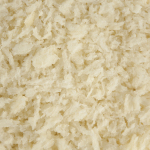
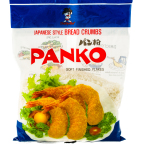 Panko hails from Japan and it is becoming ever so popular! Its’ a type of crisp, light, larger breadcrumb than what you have seen in the past. The crumbs are used to coat food for frying or sauteing and you can use in recipes as well. Many cooks use as a filler for meatloaf and meatballs. Because the texture is more coarse than the smaller finer powdery breadcrumbs, it makes a delicious crunchy crust. Now that it’s more popular you can find at most grocery stores in the Asian Section. I like to use it as the coating for our fabulous crabcakes with a little Cajun seasoning added in!
Panko hails from Japan and it is becoming ever so popular! Its’ a type of crisp, light, larger breadcrumb than what you have seen in the past. The crumbs are used to coat food for frying or sauteing and you can use in recipes as well. Many cooks use as a filler for meatloaf and meatballs. Because the texture is more coarse than the smaller finer powdery breadcrumbs, it makes a delicious crunchy crust. Now that it’s more popular you can find at most grocery stores in the Asian Section. I like to use it as the coating for our fabulous crabcakes with a little Cajun seasoning added in!
The Fabulous Pistachio
Pistachios grow well under hot, dry climates with cool winters. They are currently being cultivated in large scale in the orchards in the USA, Iran, Syria, Turkey, and China. The fruit, in fact, is a drupe (fruit with a large, central located single seed), and its seed kernel is actually the edible portion. On the exterior, the mature fruit features hard, off-white color shell which splits apart exposing yellow-light green, oblong shape kernel inside. Pistachio kernel measures about 1 inch in length and 1/2 inch in diameter and weighs about 0.7-1 gm. Pistachios are delicious tree nuts recognized for their wholesome nutrition properties. Together with walnuts, almonds and cashews, they form important source of protein, fats, and minerals to otherwise dry and arid regions of Central, West and South Asian population.
Pistachios are rich source of energy; 100 g of nuts provides 557 calories. In addition, they are rich in mono-unsaturated fatty acids like oleic acid and an excellent source of antioxidants. Regular consumption of pistachios in the diet helps to lower total as well as bad LDL cholesterol and increases good HDL cholesterol levels within the blood. Research studies suggest that Mediterranean diet that is rich in dietary-fiber, mono-unsaturated fatty acids, and antioxidants help to prevent coronary artery disease and strokes by favoring healthy blood lipid profile.
What is Israeli Couscous?
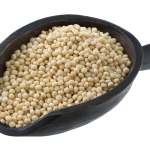 Israeli couscous, also called pearl couscous, is similar to regular couscous in that it’s a small, whole grain-like food made from semolina or wheat flour. While I’ve always seen it labeled as Israeli couscous, others might know it as “pearl couscous”.
Israeli couscous, also called pearl couscous, is similar to regular couscous in that it’s a small, whole grain-like food made from semolina or wheat flour. While I’ve always seen it labeled as Israeli couscous, others might know it as “pearl couscous”.
So, what does it taste like? Because of its size, Israeli couscous has a slightly chewy texture, similar to barley, and, because it’s toasted, it has a slightly nutty flavor. Like regular couscous and other whole grains, however, Israeli couscous is rather bland on it’s own, and needs to be prepared with seasonings, spices, sauces or fresh herbs.
Because Israeli couscous is made from wheat flour, it is not a gluten-free food, though it is vegetarian and vegan. Israeli couscous also has a low glycemic index, making it a healthy and high-fiber food.
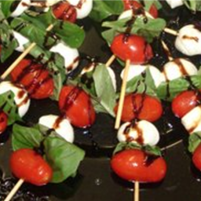
How to Make Caprese
A refreshing simple salad of fresh mozzarella, tomatoes and basil is called “Caprese”. You can drizzle with extra virgin olive oil and sprinkle with salt and pepper and even add a little balsamic to give yourself a tasty “nosh”. It takes it’s name from the southern island of Capri located in the Gulf of Naples in Italy. Ok, let’s go!
OctoberFest if here!
Well, it’s the middle of October and you know what that means? October-Fest! Featuring German food – a German potato salad is always welcomed at a feast. It’s a bacon-studded (yay!) potato salad with a dressing of bacon fat, vinegar, seasonings and sometimes sugar. It can also have minced onions, celery and green pepper it you like – it can also be served warm or cold.
Viva La Crepe!
The French word for pancake is “Crepe” which describes their paper-thin light weightiness. They can be savory or sweet depending on how you use them – for breakfast, lunch or dinner. And don’t forget to sauce them too, and for the sweet ones, a lovely chocolate drizzle!
Chinese New Year – All Year Long!
Chinese New Year will last until February of 2015 so it’s ok in my book to expound on a bit of Chinese cooking history. Did you know China is a country where the preparation and appreciation of food has been developed to the highest level?
The art of Chinese cooking has been developed and refined over many centuries. Emperor Fuxi taught people to fish, hunt, grow crops and to cook twenty centuries before Christ. However, cooking could not be considered an art until the Chou Dynasty
The two dominant philosophies of the Chinese culture are Confucianism and Taoism. Each influenced the course of Chinese history and the development of the culinary arts. Confucianism concerned itself with the art of cooking and placed great emphasis on the enjoyment of life. To the Chinese, food and friends are inseparable. A gathering without food is considered incomplete and improper. I totally agree with this – wouldn’t you?
Confucius loved and respected the art of cooking. He established culinary standards and proper table etiquette. Most of these are still considered to be the standards even today. The tradition of cutting foods into bite size pieces during preparation is unique to the Chinese culture. The use of knives at a Chinese dinner is considered “poor taste.” No wonder they used to look at me funny at the Chinese Restaurant when I was a kid when I asked for a knife to cut up my dim sum smaller.
Confucius taught that good cooking depends on the blending of various ingredients and condiments rather than the taste of the individual elements. He believed that in order to become a good cook one must first be a good matchmaker. The flavors of the ingredients must be blended with harmony. Without harmony there is no taste. He also stressed the use of color and texture in preparing the dish. Most certainly Confucianism helped elevate cooking from a menial task to the status of an art, “the art of Chinese cooking.” This is why ginger, onions and garlic are so widely used in the style of Chinese cooking
Taoism was responsible for the development of the hygienic aspects of food and cooking. The principle objectives of this philosophy were people’s wish for longevity. In contrast to supporters of Confucianism who were interested in the taste, texture and appearance, Taoists were concerned with the life-giving attributes of various foods. This gives credence to the making of “Long Life” Noodles each Chinese New Year.
Over the centuries the Chinese have explored the world of plants, roots, herbs, and seeds to find life-giving elements. They discovered that the nutritional value of vegetables could be destroyed by improper cooking and that many items had medicinal value. For example, ginger, a favorite condiment, is also used to soothe an upset stomach and as a cold remedy. Which is why you see more gingered featured as tea and candy now on the market. Don’t be afraid of the ginger knob 🙂
Unlike the majority of eastern cuisines most Chinese dishes are low-calorie and low-fat. Food is cooked using poly-unsaturated oils; milk, cream, butter and cheese are not a part of the daily diet. Animal fats are kept to a minimum due to the small portions of meats used. Please note, however, that some dishes served in Chinese restaurants may be considerably higher in calories and fats than those in any cookbook recipes that you prepare at home. So be careful of those hidden calories if you’re watching the waistline!




